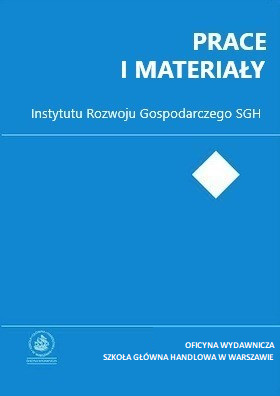Expectations' Formation in Business Survey Data
##plugins.themes.bootstrap3.article.main##
Abstrakt
In this paper we conduct a three step analysis of business tendency survey data in order to establish (1) common factors driving responses to groups of questions in the business tendency survey conducted among firms in the manufacturing industry in Poland, (2) factors responsible for respondents' answers regarding assessments (present) and expectations (future), and (3) interrelations between current assessments and expectations. We start by performing a check of the factor structure with multi-group confirmatory factor analysis (MGCFA) models in order to establish common factors responsible for sets of answers in the area of assessments and expectations, respectively. Then, we proceed with structural equation modeling (SEM) framework in order to define period-specific relations between the factors. With the final structural model we show that most answers in the area of current assessments and expectations of companies are in line with the stylised facts. We also demonstrate that the companies' response pattern did not change during the financial crisis.(original abstract)
##plugins.themes.bootstrap3.article.details##
Bibliografia
Białowolski, P., Dudek, S. (2008). Wzorce formułowania ocen i prognoz przez polskie gospodarstwa domowe – fakty i mity. Prace i Materiały IRG, 80, 43-61.
Białowolski, P., Kuszewski, T., Witkowski, B. (2010). Business survey data in forecasting macroeconomic indicators with combined forecasts.
Contemporary Economics, 4 (4), 41-58.
Białowolski, P., Kuszewski, T., Witkowski, B. (2013). Bayesian averaging of classical estimates in forecasting macroeconomic indicators with application of business survey data. Empirica. doi:10.1007/s10663-013-9227-x Białowolski, P. (2011). Analiza formułowania ocen i prognoz przez gospodarstwa domowe z wykorzystaniem modelowania równań strukturalnych. Prace i Materiały Instytutu Rozwoju Gospodarczego, 87, 141-164.
Bovi, M. (2009). Economic versus psychological forecasting. Evidence from consumer confidence surveys. Journal of Economic Psychology, 30 (4), 563-574. doi:10.1016/j.joep.2009.04.001 Brown, T. A. (2006). Confirmatory Factor Analysis for Applied Research. New York, NY: The Guilford Press.
Browne, M. W., Cudeck, R. (1992). Alternative ways of assessing model fit.
Sociological Methods and Research, 21, 230-258.
Costantini, M. (2013). Forecasting the industrial production using alternative factor models and business survey data. Journal of Applied Statistics, (July), 1-15. doi:10.1080/02664763.2013.809870 Davidov, E. (2008). A cross-country and cross-time comparison of the human values measurements with the second round of the European Social Survey.
Survey Research Methods, 2 (1), 33-46.
Davies, A., Lahiri, K. (2000). Re-examining the rational expectations hypothesis using panel data on multi-period forecasts. In Analysis of Panels and Limited Dependent Variable Models. Cambridge University Press.
Hu, L., Bentler, P. M. (1999). Cutoff criteria for fit indexes in covariance structure analysis: Conventional criteria versus new alternatives. Structural Equation Modeling, 6 (1), 1-55.
Kaplan, D. (2009). Structural Equation Modeling. Fundation and Extentions.
Los Angeles: SAGE Publications.
Katona, G. (1946). Psychological analysis of business decisions and expectations. American Economic Review, 36 (1), 44-62.
Katona, G. (1947). Contribution of psychological data to economic analysis.
Journal of the American Statistical Association, 42 (239), 449-459.
Koeberl, E. M., Lein, S. M. (2011). The NIRCU and the Phillips curve: an approach based on micro data. Canadian Journal of Economics, 44 (2), 673-694.
Lemmens, A., Croux, C., Dekimpe, M. G. (2007). Consumer confidence in Europe: United in diversity. International Journal of Research in Marketing, 24, 113-127.
Matsunaga, M. (2011). How to factor-analyze your data right: Do’s, don’ts, and how-to’s. International Journal of Psychological Research, 3 (1), 97-110.
Millsap, R. E., Yun-Tein, J. (2004). Assessing factorial invariance in ordered-categorical measures. Multivariate Behavioral Research, 39 (3), 479-515. doi:10.1207/S15327906MBR3903_4 Muthén, L. K., Muthén, B. O. (2012). Mplus User’s Guide. Los Angeles, CA: Muthen&Muthen.
Osborne, J. W., Costello, A. B. (2004). Sample size and subject to item ratio in principal components analysis. Practical Assessment, Research & Evaluation, 9 (11).
Paloviita, M., Viren, M. (2012). What’s behind the survey values? An analysis of individual forecasters' behavior. Paper presented at the 31st CIRET Conference, Vienna, September 2012.
Picchetti, P. (2012). Tracking expectations formation from business tendency surveys. Paper presented at the 31st CIRET Conference, Vienna, September 2012.
Siliverstovs, B. (2009). Evaluating short-run forecasting properties of the KOF Employment Indicator for Switzerland in real time. KOF Working Papers, 226.
Zarnowitz, V. (1992). Rational expectations and macroeconomic forecasts. In V. Zarnowitz (ed.), Business Cycles: Theory, History, Indicators, and Forecasting (pp. 462–491). Chicago: University of Chicago Press.
